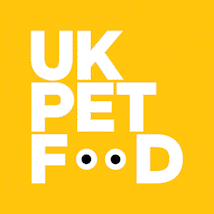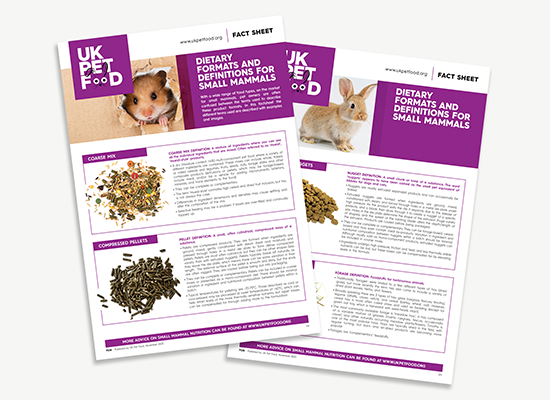Demystifying the terminology used for small mammal pet food formats
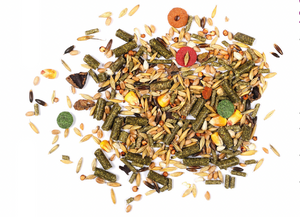
Coarse mix
A mixture of ingredients where you can see all the individual ingredients that are mixed.
Often referred to as ‘muesli’, ‘muesli-style’ products
- A dry (moisture content <14%) multi-component pet food where a variety of different ingredients are combined. These mixes can include whole, flaked, or rolled cereals and legumes, fruits, seeds, nuts, forage stalks and other composite products (extrusions or pellets, which may be forage-based, include meat, and/or be a vehicle for adding micronutrients (vitamins, minerals, and trace elements to the food).
- They can be complete or complementary.
- The term ‘muesli-style’ connotes high cereal and dried fruit inclusion, but this is not always the case.
- Differences in ingredient dimensions and densities may cause settling and alter the composition of the mix.
- Selective feeding may be a problem if bowls are over-filled and continually topped up.
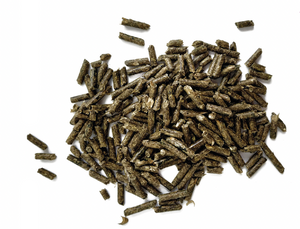
Compressed pellets
A small, often cylindrical, compressed mass of a substance.
- Pellets are compressed products. They are formed when ingredients are ground, mixed, gently conditioned with steam (heat and moisture) and pressed through holes in a metal die plate to form dense compacted pellets. Pellets are most often cylindrical, but they can be other shapes (less variety than with extruded nuggets). Pellets typically break off naturally as they leave the die plate, which means there can be some variation in their length. The external surface of the pellet is smooth and shiny, but the ends are often ragged. They are cooled before being put into packaging.
- They can be complete or complementary. Pellets can be included in coarse mixes or presented as a mono-component diet. There should be minimal variation in ingredient and nutritional composition between pellets within a batch.
- Typical temperatures for pelleting are ~70-75°C. Those described as cold or cool-pressed may be processed at lower temperatures of ~40°C, which can help retain levels of the more thermally sensitive nutrients, but again losses can be compensated for through adding more to the formulation.

Extruded nuggets
A small chunk or lump of a substance. The word ‘nuggets’ appears to have been coined as the small pet equivalent of kibbles for dogs and cats.
Nuggets are mostly extruded expanded products and can occasionally be baked.
- Extruded nuggets are formed when ingredients are ground, mixed, conditioned with steam, and forced through holes in a metal die plate under high pressure. As the product exits the die it expands due to the release of pressure, and a blade then slices through it to create a nugget of a specific size. Holes in the die plate determine the shape of the extrusion (huge variety of shapes), and the speed of the rotating blade alters the depth/length of the extrusion. Products are cooled before being packaged.
- They can be complete or complementary. They can be forage-based, cereal-based and may even contain meat by-products. Variation in ingredient and nutritional composition between nuggets within a batch should be minimal. Although mostly sold as mono-component products, extruded nuggets can be included in coarse mixes.
- Ingredients undergo high pressure, friction and heat, and less thermally stable nutrients can be lost, but these losses can be compensated for by elevating levels in the formula
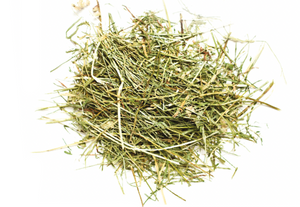
Forages
Foodstuffs for herbivorous animals.
- Traditionally ‘forages’ were limited to a few different types of hay (dried grass), but more recently the term has also come to include a variety of dried plant leaves, herbs, and flowers.
- Broadly speaking there are 3 types of hay: grass (ryegrass, fescues, timothy), legume (alfalfa, clover, vetch), and cereal (barley, wheat, oat). However, cereal hay is more often called straw and used as bedding (except for green oat hay, which is harvested with seed-heads intact).
- The most commonly available forage is ’meadow hay’, a hay composed of a variable mixture of grasses (mainly ryegrass, fescue, occasionally clover) and other naturally occurring meadow plants/flowers. Timothy is one of the most popular hays. Hays are typically dried in the field, with regular turning, but barn and air-dried products are becoming more popular.
- Forages are ‘complementary’ feedstuffs
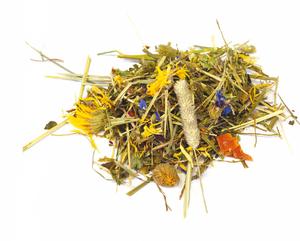
Foliage & flowers
A collection of leaves.
- Also falling under forages (and perhaps natural treats) are various dried plant leaves, herbs, and flowers, which can be presented as individual products and/or within forage mixes. These were traditionally found growing within natural meadows, hedgerows, and verges, and often fed fresh to small herbivores, but in recent years they are being specially cultivated, harvested and barn or air-dried. Leafy green vegetables are also considered as foliage but are fed fresh.
- The list of plants is diverse, growing and examples include:
- Plant leaves: Soft fruit (blackberry, blackcurrant, raspberry, strawberry), tree (apple, mulberry, pear).
- Herbs: Coriander, chervil, dandelion, lemon balm, mint, nettle, parsley.
- Flowers: Chamomile, cornflowers, echinacea, hibiscus, lavender, mallow, marigold and rose.
- Plant leaves, herbs and flowers are ‘complementary’ feedstuffs.
- There can be tremendous variation in nutrient levels depending on species used (and combinations thereof), season and storage conditions
Treats & chews
Treats are ‘complementary’ feedstuffs.
Often the differentiation between chews and treats is the amount of time it takes for the pet to consume the treat – a treat is typically consumed quickly, whereas a chew lasts longer. In rabbits and rodents, chews tend to be called gnawing treats.
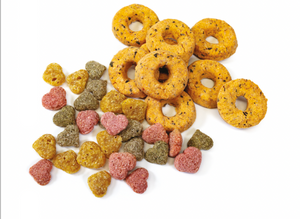
Treats (natural or manufactured)
- Natural: Dried foliage and flowers, nuts, seeds, dried fruits and vegetables.
- Manufactured: Extruded or baked (different colours, shapes, dimensions, textures, with and without pockets), vegetable drops.
- Because of the diversity of treat types there can be tremendous variation in nutrient levels. Care must be taken when feeding any higher calorie treats to small pets. The size of each treat, relative to the size of the pet, means that they can easily consume far more calories than they actually need.
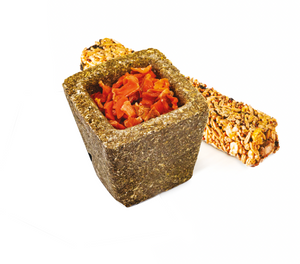
Gnawing treats/chews (natural or manufactured)
- Natural: Products like twigs, bark and roots
- Manufactured: Products that are compressed or formed in moulds. They can be cube, cookie or stick-shaped, layered or filled, and may be forage, cereal or seed-based. These products may, but not always, contain binders (including syrups, starches and oils) to hold the ingredients together. ‘Stickle’ treats are a type of gnawing treat, which consists of a mixture of ingredients (like oats, seeds, nuts, dried fruit and vegetables) formed around a central stick.
- Manufactured gnawing treats are ‘complementary’ feedstuffs.
- Again, there can be tremendous variation in nutrient levels between different gnawing treats depending on ingredients and recipe. Gnawing treats can be quite large and should therefore be fed infrequently. Stickle treats are hung in cages to encourage the small pet to work for their reward, a little bit at a time, rather than eat it in one sitting. Consumption must be monitored daily to avoid overconsumption, especially when first introduced which can upset the pet’s sensitive digestion.
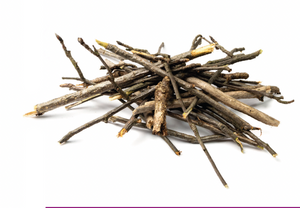
Roots, stems, twigs & bark (natural gnawing treats)
Often classed under both forages and treats, wood products, twigs and bark, stems and roots are also often offered to rabbits and rodents.
Whilst they may be ingested, they are not typically classed as foodstuffs, but rather as natural gnawing treats or chews.
- Safe materials include:
- Roots: Dandelion
- Stems: Reeds, seagrass, willow, water hyacinth
- Twigs, Wood and Bark: Apple, pear, birch, hazel, willow
- Materials like willow and strong grass stems from water hyacinth, seagrass and reeds are often woven, to create interesting wicker shapes – like balls, baskets, tunnels, hideaways etc.
- The fibre content of these materials can be quite high and can contribute to the overall fibre intake of the small pet
